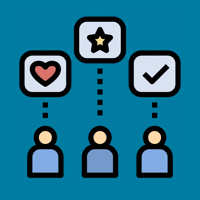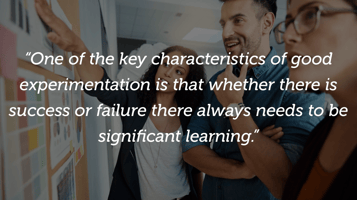Personalization Requires Segmentation
This is part six and the final post of our series based on what I learned at the IAMPHENOM...

The coronavirus pandemic has hit us like a global earthquake.
Several industries have been completely thrashed by this crisis and have already cut or furloughed the entire Talent Acquisition team. There are also some that are growing and thriving. But for many businesses, a part from a little trimming, we are in a wait and see holding pattern.
How much damage has been done?
Will it be a fast or slow recovery?
What will happen in the third and fourth quarter?
And while we are all trying to figure out the new normal, no one is paying attention to the rapidly receding ocean waters and impending tsunami!
While there are a whole lot of unprecedented aspects of this recession, just like every other downturn in my lifetime I expect the inevitable will happen: Talent acquisition functions will be gutted. There, I said it.
(BTW, if you are a recruiter and have already been impacted check out Recruiters Recruiting Recruiters).
But then the markets will come back and the need to hire and retain talent will be the top priority again. When this happens, will you recreate the same operation you had pre-tsunami just like we did after 9/11 and the 2008 Financial meltdown? Will you hire back the same recruiters, sourcers, recruiting coordinators to manage the same process?
Studies have show that when the economy and job market was roaring, more than 60% of recruiter’s time is spent on tasks that could easily be automated. At the same time organizations have struggled with the Talent Experience because the people don’t have enough time to spend on high touch value added activities.
If you’re in Talent Acquisition and still have a job, it is time to start thinking about what you will do differently the next time around. It is a good time to consider a transformation.
Here is a 6 step model for implementing a Talent Experience Digital Transformation:
Before you begin a Talent Experience Digital Transformation you need to make sure you have an adequate technology foundation. Most organizations have some variety of tools for different aspects of the talent experience such as career sites, applicant tracking systems, CRMs, landing pages, talent networks, chat bots, etc. A patchwork of stitched together solutions can be problematic and now is the perfect time to take an inventory of your tech stack and look for opportunities to consolidate and eliminate point solutions.
Additionally you will need to identify gaps in your tech stack. There are four key technology elements you will need for a true digital transformation:
More on the technology in step 6.
Segmenting your talent will actually serve two purposes. First and foremost one size does not fit all. You will want to differentiate the experiences that you design based on your target audience. Secondly, it might be overwhelming to try and address all of your talent at once, like trying to boil the ocean. You may want to focus first on your most critical roles. Here is a great way to start segmenting your talent:
My good friend Linda Brenner at Talent Growth Advisors taught me this approach to talent segmentation. First rate your roles based on criticality to the business, and then determine how available the talent is in the market. This will provide you with the following 4 segments:
The bottom line is, you will want to employ different approaches for each of these segments, and you may also want to focus on just one to get started.
Once you have divided your roles into the relevant segments, the next step is to define the Talent Personas for each role, or groups of similar roles. Depending on how many roles you have, you may want to start with one segment, or focus on one role per segment.
For this you can take a page right out of Customer Experience where you describe your target profile in great detail. Just google “Buyer Persona Canvas” and you will find a plethora of examples, styles and formats to use. One thing you must keep in mind though is that there are fundamental differences between Talent Experience and Customer Experience.
With Customer Experience the goal is to identify the buyer and get everyone to become a customer. Which is probably why so many of the examples you will find include demographics and have pictures to bring the persona to life. In Talent Experience, we want to identify and attract a persona, but we also will be selective and decide who we actually want to pursue.
You will want to keep the personal demographics out of your talent persona canvas, and also make sure that in addition to defining the attributes that will help you attract the talent, you will want to define the selection criteria to be used in assessing the fit to the role.
Here is an example of a buyer persona canvas, converted to the Talent Experience mind set.
The Persona Canvas is a great tool to understand what elements of your EVP aligns with your target talent communities and will help you identify the digital content required to best engage them.
After you have developed your Talent Personas the next step will be to map the journey. This is not just your typical process mapping exercise and will take some more work. But the good news is you will not need to reinvent the wheel because journey mapping for customer experience is well established and you can find a variety of examples with a simple google search.
Here is an example of a Candidate Journey Map from Phenom’s knowledge base that I have used in several workshops. The idea here is to plot all of the possible touch points for a particular persona, and include the motivational triggers that moves a candidate from stage to stage, along with an assessment of what they are thinking, feeling and experiencing at each step.
You may have a pretty good understanding of your target persona and their typical journey, however to do this well you will want to conduct research for the personas and journey maps. You can identify employees to conduct interviews, hold focus groups, or send surveys to employees and past candidates to collect this kind of information.
Also – Don’t forget that your journey map will differ between External Talent and Internal Talent, and you will want to account for how Employee Referrals are carried out in the experience.
Experience Design sounds pretty straight forward, but it is actually pretty challenging to control every single touchpoint in the talent life cycle and make the experience amazing. The best way to approach this is to focus on a select set of key interactions that you can redesign to become “Peak Moments.”
If you have not yet read the book The Power of Moments, I highly recommend that you do. It is a quick read and provides a great framework for this experience design. One of the key concepts in the book is that people evaluate an experience not by summing up the average rating of every touchpoint, but will they will measure it more based on how they feel about Peak Moments. Peak moments will have one or more of the following 4 elements:
You can read the book for more about designing the moments. We have developed an approach to use Moments of Truth (MOT) from the marketing world to identify targets for the Talent Experience. The slide below will provide you with some ideas on Talent MOT’s you can focus on.
You might have been wondering why the technology gap analysis comes first in this model. Traditional consulting methodologies might have you develop your strategy, define your processes, and build a 250 row requirements document before evaluating your current technology. However that takes a long time to just get to the gap analysis. And then you will need to tack on even more time to develop your go forward technology strategy.
We believe that with a deep enough understanding of the subject matter and marketplace, we can conduct the gap analysis up front and develop the strategy and roadmap concurrently with the talent segmentation and experience design work. This way by the time you get to the final step your tech strategy is in flight.
In step 6 you will tap into your tech stack (or roadmap) to implement Talent Process Automation (TPA) Workflows that can eliminate as much of the manual repetitive steps as possible.
When you are developing your TPA’s you will first want to do extensive analysis of your data to identify the best opportunities for automation. In robotic process automation this is referred to as Process Mining, where you let your data tell you what is actually happening rather than rely on some old process documentation that may or may not be what’s actually happening.
You will also want to consider adding Human Decision points for a period of time to monitor the consistency and quality of the data that will ultimately drive automated decision making (i.e. who makes it to the next step). Here is a high level example of two options for the Automate segment as defined in step 2:
Here is another high level example of two TPA options for the Cultivate & Assess segment where assessments have been added as well as automated nurturing campaigns to keep your talent community engaged:
While you might find some TPA opportunities in the Hight Touch segment, I think it is a good strategy to focus first on reducing the administrative and repetitive tasks of the Automate and Cultivate & Assess segments. This approach will allow you to prepare for the recovery, and when you’re ready to hire back your talent acquisition team you will not need to staff for the highly repetitive and administrative tasks. You can focus your limited human resources on the more value added activities in the High Touch talent experiences.
Ultimately the TPA’s you create will be based on your specific circumstances. But what I think is most important is that you develop TPA’s in the context of a complete talent experience digital transformation. I have worked with many clients in this area, and there is a natural tendency to focus on the technology and jump to the automations. But after digging in it becomes quickly evident that segmentation, persona development, journey mapping and content strategy are all necessary steps to design and differentiate your talent experience.
It has never been a better time to start a Talent Experience Digital Transformation.
What are you waiting for?
Drop me a comment or hit me up on LinkedIn – I would love your feedback.
Get updates and learn from the best

This is part six and the final post of our series based on what I learned at the IAMPHENOM...

This is part two of a series of posts based on what I learned at the IAMPHENOM conference.

This is part five of a series of posts based on what I learned at the IAMPHENOM conference.